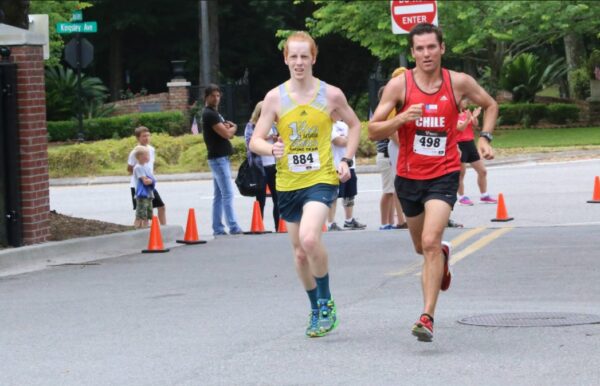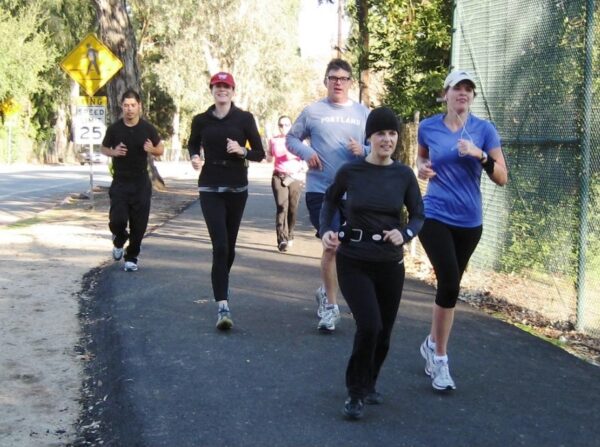The 10-20-30 running training method gives you the opportunity to achieve successful and simple running training to kick-start your body and make it both healthier and stronger. This training method gives really good results, especially for beginners and less experienced runners. In 10 exciting reasons to use new documented running training, the aim is to show how the method has a very positive effect, based on results from a research project about running from the Department of Sport at the University of Copenhagen/Denmark.

Documented Running Training
The documented 10-20-30 running Method shows that runners who run 2-3 times a week achieve significant performance improvement and improved health when they run 10-20-30 interval training and halve the amount of training. However, you need to have a healthy running basis before starting.
Runners have achieved a 4 percent increase in their fitness numbers. On average, they improved their 5 km time on almost one minute (from 23 min and 4 sec. To 22 min. And 16 sec.) And had a performance improvement of 21 seconds on a 1500-meter run.
At the same time, they had a drop in blood pressure and lower total cholesterol in the blood – ie a significantly improved health profile, according to Professor Jens Bangsbo, who was the leader of the research project. He adds that no changes were detected by a control group that continued the normal training under the supervision of the researchers.
Effect of the running training method
You can achieve significant time improvements on distances from 5 kilometers and up to a half marathon. The amount of training is smaller, but more intensive compared to traditional running training. The training can be completed in approx. half an hour/session and has proven very effective, although the intense part only lasts 2-3 minutes per training session.
The intense part of the 10-20-30 workout leads to much higher activation of both muscles and cardio system than during normal training. Thus, the heart is stimulated more and more blood is transported to the muscles. At the same time, some muscle fibers are activated, which are not normally trained.
The muscles also become better at absorbing oxygen and sugar as well as utilizing fat. This means that you can run at a higher speed with the same sugar consumption and thereby e.g. improve your time during a 5-km race.
The 10-20-30 method was developed as an attempt to avoid the long sprints that are characteristic of other interval methods. By sprinting, almost all muscle fibers will be active. This also applies during the short 10-second sprints, which in this way set all the muscle fibers in motion.
The fastest and most powerful muscle fibers are only active for a very short time before they become exhausted and need a break before they are ready to be activated again.
Key Points
That break they get during 30-second runs at a slow pace. This is the reason why you can maintain almost maximum running speed in each of the 10-second intervals, and thus train some muscle fibers that would not otherwise be trained.
The participants in the experiment also had their blood pressure measured before and after the test period. Blood pressure is one of many methods to get answers to a person’s general health. There was no noticeable improvement in blood pressure in those with normal blood pressure.
But there were blood pressure improvements in participants with slightly elevated blood pressure. If you have more than 140/90 in systolic/diastolic blood pressure, you have slightly elevated blood pressure.

Focus on training motivation
Many joggers/runners experience stagnation in their performance and periods with a lack of desire to train, for example, due to limited time to run and lack of motivation during the repeated monotonous runs.
With the limited time consumption and the possibility of achieving significant improvements, the 10-20-30 training will be VERY attractive to many runners, where limited time and lack of progress can mean that they stop running.
Many new runners stop running again because they think it is too hard, too boring, does not really have an effect, or takes too much of their time.
Facts about the 10-20-30 method for running training
The 10-20-30 interval running method has been developed by researchers at the Department of Sport at the University of Copenhagen and i.a. tested on 200 runners. It is scientifically proven that 10-20-30 training makes runners faster, healthier, and more excited by running. With 10-20-30 runs, you change pace regularly and only work intensively for 10 seconds every minute. You are running:
30 seconds low pace
20 seconds moderate pace
10 seconds sprint.
It is a type of training where the running pace changes. Run at a low pace for 30 seconds followed by a 20 second run at a moderate pace and then a 10-second fast run/sprint. You repeat this three to five times. Then take a break two to four-minute break. Such five-minute periods you perform one to four times during a training session depending on your running shape.
The good thing about this type of training is that everyone can participate because it is about relative load. The whole essence of this kind of training is the intensity. It is the intensity and the pressure you put on your body that makes the difference.
10-20-30 runs make you faster, healthier, and more motivated. The training has an effect, regardless of whether you are a beginner or an experienced runner. Read below how to get started.
How to Start Running Training With the 10-20-30 Method
Startup gently
Whether you are a beginner or an experienced runner, it is important to start gently. Even the elite runner will experience that it is hard training and experience a soreness up to a week after starting. The soreness is a positive signal that you have used your body and that the body is in the process of preparing to do even better next time. It is also called Supercompensation.
As a Newbie – Run for 4-8 Weeks Before 10-20-30 Training

If you are a beginner, it is important to get more miles in your legs before you start with 10-20-30 runs, because of the injury risk. When you can run 3 km without a break, you can start experimenting with speed. A way to speed up your training might be to push yourself to run faster from one lamppost to another, increase speed up hills or the like.
Warm-Up Thoroughly
10-20-30 runs are effective training in a short time. That said, it is important not to save time on warm-up! It’s very important to warm up 15-20 min. and increases the pace in the last minutes so that the body is warm and ready for the training. It reduces the risk of injury and makes training more effective.
It is especially the back of the thigh that can get injured due to the explosive force development when you start the 10 seconds sprint. High heel kicks, knee lifts and similar exercises that focus on the muscle groups are therefore important to include in the warm-up and stretching.
Start with 10-20-30 runs once a week
Both beginners and experienced runners should not start with more than one training session with 10-20-30 run once a week for the first two weeks. It is essential to hold back a bit to stay 100% injury-free.
If you are used to running, then possibly run a regular trip as well – the first two weeks. After this, the 10-20-30 training constitutes an entire training session. Once you get started you will find that even the most energetic runner will feel that it is hard enough!
Do not increase the training volume – rather the intensity
The many tempo shifts and the increased intensity are fundamental in- and play a crucial role if you want to improve your shape and performance. When you increase the intensity of the training, it is important that you give the body time to recover from the increased loads in the individual training sessions, which means reducing your amount of training – both in terms of kilometers and time.
You can start with two sessions of 5 x 1 min. with 10-20-30 runs. The first session is used to slowly increase the speed of your sprints. Graduate your pace so you hold back and only give 100% on the sprint at the last minute.
In the second session, you run through with 100% on all your chosen repetitive sprints. It is important to accustom the body to the routine and the rapid shifts in pace.
You can also try setting the pace up to 20 seconds instead. When you can complete a session at maximum speed, you can complete one more session. Expand your repetitions afterward based on how you feel.
Because, for even the most trained runner, it will be unlikely to run more than 4 x 5 min. You will be burned out no matter how skilled you are.
Focus on the 10 seconds sprint part

Most of the effect from 10-20-30 training comes from the 10-second sprint where you recruit the big part of the body’s resources. Rather, set the pace down to the 20-second moderate pace so you are ready to run and give yourself all you can in those 10 seconds.
Walk or jog in the breaks
The 30 seconds are meant as a break. Whether you walk or jog is up to you. It’s like in more classic intervals, where the breaks are used to get the heart rate down a bit and get the body ready for the next running interval – You get the necessary effect anyway.
Run on well-known routes
It is a good idea to warm up in the same place – and know the route for your 10-20-30 training. Then you know the procedure and do not face unforeseen challenges or need to think about how your route will be when you start training.
Take special care if you run in the dark at night. It does not necessarily have to be boring to run the same route over and over again – your focus will not be on nature and the surroundings at all once you start the 10-20-30 run.
Run with others in a group!
The researchers behind 10-20-30 recommend that you train with others. Even the fastest runners have different top speeds, and there are limits to how far you can get away from each other in the 10-second sprint.
In return, you can push each other to get going and take turns taking time. If you are running in a group, it is a good idea for everyone to change position during the 30 seconds, so the fastest runners are last before the next start.
Then the fastest will have some to chase at the next sprint, as they are now at the back of the group. And those who are now at the front can try to keep the fastest behind them. This gives everyone – regardless of level – the opportunity to have someone to hunt and fight against.

Remember focused warm-up
The researcher wants to emphasize that this is high-intensity training and the whole essence of this type of interval training is precisely the intensity. It is the intensity and the pressure you put on your body that makes the difference.
Whether you are a new starter or an experienced runner, it is therefore important to have a focused warm-up and a gentle start-up in the number of repetitive intervals.
As mentioned, It is especially the hind thigh that can get injured because there is an explosion in muscles and fibers when you start the sprint. High-heel kicks, knee lifts and similar exercises that focus on those muscle groups are important. And preferably five minutes longer warm-up than with regular training.

Final Thoughts
A large part of the conclusion from the 10-20-30 project is that both younger, older, new and experienced runners can achieve a significant improvement measured in performance in time. In addition, there are many indications showing the runners found it fun, rewarding and challenging.
The method has been tested on runners from 24 to 70 years and also shows that runners not only improve their speed and health by running 10-20- 30 interval training. Motivation is also sharpened – for both young and old as well as beginners and experienced runners.
The Challenge for you now could be to test it out and maybe participate in more serious public races afterward.
On average, the experienced runners improved by 39 seconds in 5 kilometers. The beginners improved by 49 seconds in 3 kilometers. They ran 10-20-30 twice a week and a day of optional distance and pace. The untrained improved the most.
I hope you like this review and if you have any questions about the topic or want to leave your own Personal review, please leave a comment below.
[faq-schema id=”4918″]





